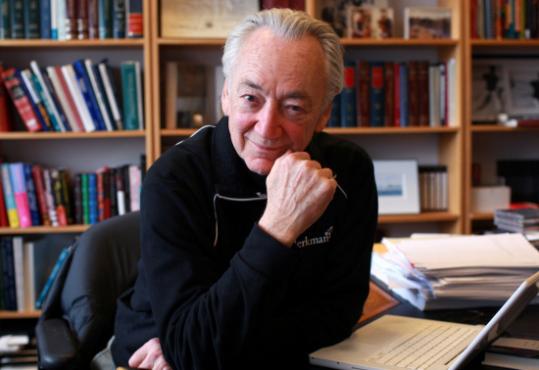

If Joel somehow wins, the RIAA has a big problem.If there is a judgment of tens of thousands of dollars against Joel, then Joel has a big problem.If there is a judgment of hundreds of thousands against Joel, then both he and the RIAA have a big problem.If there is a judgment of millions against Joel, it's mostly the RIAA's problem.
(emphasis added)
Ben Sheffner, who has covered this trial really well despite his admitted sympathy for the RIAA’s position,
agreed with me.
A jury in the Federal Court in Boston on July 31, 2009 found Joel Tenenbaum liable for $675,000 for willfully downloading and distributing 30 songs. That’s $22,500 for each song. That's my third bullet.
I wonder what other advice Joel was given by the legal team led by Prof. Charles (“Billion Dollar Charlie”) Nesson, the famous evidence and cyberlaw professor at Harvard Law School(“HLS”) and the enthusiastic Berkman Center law students and some veteran Boston practitioners.
There are going to be a lot of questions as to why Joel didn't settle at the outset for a few thousand dollars, and whether he was later well served by the controversial strategy and behaviour of Prof. Nesson. What convinced Joel to take such an enormous risk?
It's not clear from all the tweet and blog reports that there was much if any evidence led by Nesson or elicited on cross examination that could have helped Joel with respect to such obvious issues as:
• A fair use defense, however unlikely it would have been to succeed. In fact, the defense was thrown out by the Judge before the trial because of a complete lack of evidence that might have somehow supported it. Prof. Oberholzer-Gee, also at Harvard, was the obvious expert witness who might have helped Joel on this front. His study is or ought to be known to everyone familiar with the P2P debate. If fair use was the Hail Mary pass that Prof. Nesson was counting on, he was told by Lessig, Fisher, Seltzer etc. etc. that it was a loser of an argument. Nesson notoriously published many of the emails from his colleagues confirming that the argument was hopeless. Although he persisted with it, he marshalled no relevant evidence in the Judge’s mind even to give it a chance of getting heard. Apparently, no attempt was made to use Oberholzer-Gee until about a week before the trial, which was least three months too late. If Oberholzer-Gee was not available, there were others (i.e. Andersen/Frenz 2008) who could have countered Stan Liebowitz - the able economist and very experienced expert witness called by the RIAA.
• A constitutional argument about statutory minimum damages that range from $750 to $150,000 per work for much less than a dollar’s worth of actual damage. Again, Oberholzer-Gee might also have been useful here to argue that P2P sharing does no overall harm to the music industry; and,
• Whether there was any actual distribution of each of the songs to anyone other than the Media Sentry investigator.
Instead, Nesson made great efforts to call his son-in-law, Wayne Marshall, an ethnomusicologist, to give expert testimony about the cultural aspects of how and why music is “shared” and John Palfrey about “digital natives.” The Court correctly and predictably concluded that none of this was relevant.
Nesson opened Joel’s case with a lecture about the Necker cube and how things can be ambiguous and not as they seem. He also crushed some styrofoam, to show how albums have become “bits.” This is probably very entertaining in a class room.
Morever, Nesson disobeyed the Judge’s orders about recording depositions, phone calls, etc. There are show cause proceedings pending that could result in sanctions against him and/or his hapless client. Hopefully, Joel at least will be spared this last further misery.
Nesson asked the jurors if they would mind if he wore a turtleneck to court, and presumably did so. In Canada, lawyers wear robes at trials. I must say that this a one tradition worth keeping, for obvious reasons. (Especially as one who still has a full head of mostly black hair, I am glad that we at least don’t have wigs in Canada).
Nesson apparently didn’t realize until just before trial that Joel was on the hook for 30 songs and not just seven. He admitted that he “missed” that point. At what turned out to be $22,500 per song, it’s a significant point.
At the conclusion of the Defendant’s very short case, Nesson reportedly used his son-in-law to provide a computer demonstration about how to buy a song on Amazon, though the purpose of this seems quite unclear.
Reportedly, throughout the trial, Nesson drew many rebukes from the Judge and some objections were even anticipated and sustained by the Judge before they were made.
Finally, in closing arguments, Nesson reportedly made a blatant and apparently improper attempt at jury nullification, which was stopped by the Judge.
Above all, Nesson seemed obsessed with getting this trial webcast and went so far as to file one or two hopeless petitions in the US Supreme Court (it’s a bit confusing, since one didn’t actually get filed) to stay the trial pending resolution of this issue. Given the way things turned out, it’s probably just as well that nobody got to see this week of failure for Joel and the clearly shattered defense strategy that depended entirely on a far fetched theory of fair use, Necker cubes, and crumbled styrofoam.
Not having taught at Harvard, I’m perhaps not qualified to give Prof. Nesson a lesson. But, as any practising lawyer knows, a court room is not a class room.
Given the litany of problems in the defense of Tenenbaum, the result is hardly a surprise. However, given the stature of Prof. Nesson, HLS, and the Berkman Center, the nature of the defense was very surprising. Nor is it surprising that HLS has been apparently been taking actions that might suggest that it is trying hard to
distance itself from this as the outcome was becoming apparent.
The award of $22,500 for each of 30 songs is interesting. The amount of $22,500 happens to be precisely the amount that the minimum of $750 per song times 30 songs would yield. Is it just possible that the jury screwed up in filling out the form and meant to award a total of $22,500, the minimum possible amount given the directed verdict on liability? Not likely - but some are wondering. It’s an odd coincidence. Ben Sheffner
claims that this is not possible.
The award of $675,000 is a high enough award to make the RIAA look bad, especially if it actually tries to enforce it. Nonetheless, the award it is in a range that is conceivably enforceable, even it leaves 25 year old Tenenbaum financially crippled for decades and even the rest of his life. But it may not be sufficiently large and the apparently sparse evidentiary record left by Nesson on the constitutional issue may not be sufficiently adequate to sustain a finding of unconstitutionality of the statutory damage provisions or to attract the attention of the US Supreme Court on a constitutional basis.
This is a very sad moment for Joel, his family and those doubtless bright and idealistic students at HLS’s famed Berkman Center who tried to help him. This was not a good day for HLS, to put it mildly. Even if HLS has no legal responsibility to make Joel whole, HLS’s good name is going to be attached to this trial in the public perception. A lot of lawyers and academics too have been quite concerned about how Joel’s defense was handled - most notably
Ray Beckerman.
As for Prof. Nesson, he would be consistent with his previous strategy of being “open”, if he would now explain just what his strategy was and what he thinks can now be done to make Joel whole.
In fairness to Nesson, it must be said that it’s not clear that this was ever a winnable case under American law. But that said, why then go to trial and take such a obvious risk of hundreds of thousands or more against long odds to save a few thousand? The only realistic hope was and remains a finding that the statutory minimum damage provisions are unconstitutional. But that’s also a real gamble and the odds were and remain heavily against Joel. Even that argument requires a sufficient record of evidence - which may or may not be there. Nesson, who is reportedly a brilliant poker afficionado, and who advocates its use in teaching law (
here he is on Colbert) played out the cards here. But is was his client, Joel, who lost. Big time.
No doubt there will be an appeal. Perhaps there will be a new trial, if only because the Judge ruled that Joel’s admission of liability had to result in a directed verdict on that issue. Arguably, Joel could admit to downloading but not to liability, which is a legal conclusion. Frankly, however, it doesn’t look as if this jury would have spared Joel on liability even if they were given that issue to decide.
Ironically, at the end of the day, Joel might have been better off with the maximum $4.5 million award. Such an maxed out award might have been useful in helping to get the attention of the US Supreme Court.
The fear is that this case will be remembered for the fact that a typical middle class college kid, one of many millions, who loved popular music and downloaded and (supposedly) shared hundreds of songs and who had one of the most famous law professor/lawyers in the USA, a veteran Boston law firm, and a team of brilliant Harvard students behind him still couldn’t beat the RIAA.
This may discourage others with better cases, better strategies and more pragmatic counsel from pursuing winnable cases and making a lack of distriubtion, constitutional and maybe even conceivably a fair use argument based upon a solid record.
The lesson for Canada is to get rid of these dreadful draconian statutory damages that can and will be used against ordinary individuals for ordinary activity. Such laws and the way they are exploited by the RIAA and were
attempted be exploited by CRIA in Canada do not promote respect for copyright. They do exactly the opposite.
The result from the Tenenbaum trial is that that everyone lost.
HK
PS - August 23, 2009 - I've posted my response to Prof. Nesson's comment below
here.













